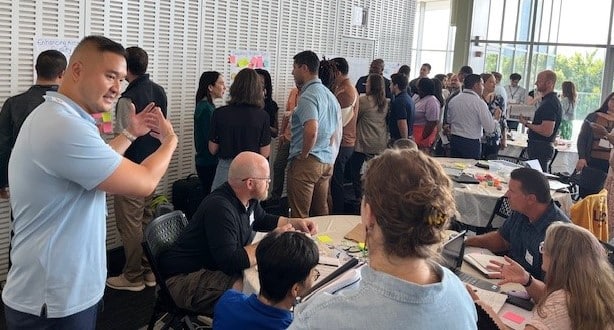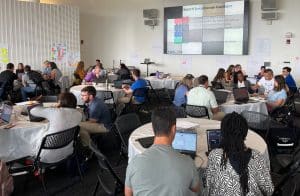An AI Design Sprint: A Glimpse into the Future of Education
CompetencyWorks Blog
The AI Design Sprint buzzed with energy as approximately 100 educators, students, thought leaders, technologists, and funders gathered at a groundbreaking two-day event co-hosted by Playlab AI and Leading Educators.
Yusuf Ahmad, co-founder of Playlab AI, outlined the goals of the gathering:
- explore how we could use technology to support human-centered learning;
- engage in this learning in community, providing time to iterate together and to connect with others similarly keen to learn; and
- experience learning through hands-on, playful activity and exploration, using design thinking and rapid testing to build and test AI tools on Playlab’s platform.
I was excited to participate as the goals of this gathering align with the Aurora Institute’s commitment to exploring a human-centered approach to artificial intelligence (AI) in education. The discussions at the Design Sprint illustrated how AI is uniquely positioned to support the principles of competency-based education (CBE) by offering personalized learning experiences and detailed insights into student progress.

Getting Primed to Design!
The first day began with a focus on human connection. The AI Design Sprint participants engaged in paired conversations, followed by collaborative work in table groups. We were encouraged to think creatively about the future, starting with a design exercise that challenged us to reimagine everyday items like a vacuum, toilet, or vehicle.
Next, we were prompted to envision the world in 2045, considering how our designs might need to evolve and what elements might remain unchanged. This exercise was eye-opening, helping us anticipate future conditions, challenges, and opportunities. Could this future include roles like AI Ethicist or Consciousness Engineer, as ChatGPT suggested? More pertinent to education, we were challenged to start thinking about what students will need to know and be able to do in 2045.
Aligned with this forward-thinking approach, we reviewed the Value-Add of Technology on Teaching (VATT) Framework from Leading Educators, which illustrated how technology-enabled instruction can enhance teaching by enabling educators to do more, do better, and explore new possibilities.
Diving into Participant-Directed Design
The learning environment mirrored the ideal student-centered setting, offering personalization and the freedom to work on projects that resonated with each participant or team. To guide our design time and tool creation, the AI Design Sprint facilitators offered several possibilities where generative AI could solve problems. They offered ideas for creating tools in three areas, including:
Planning tools:
- Coaching and Support
- Enhancing High Quality Curriculum
- Deepening Student Work
- Data Analysis and Interpretation
Student-facing tools:
- Fostering Student Collaboration
- Meeting Individual Learning Needs
General Tools:
- Problem Solving and Assistance
We were encouraged to explore these examples, select what intrigued us, and brainstorm tool ideas for each category. After reviewing the range of tool possibilities and categorizing them using the VATT Do More, Do Better, Do New framework, participants chose a tool to develop. This initiated a cycle of focused building, feedback, and rapid testing.
The emphasis throughout was on thoughtfully creating tools that could “do more” and thus help users gain capacity; “do better,” thereby increasing effectiveness, or “do new,” which meant expanding possibilities to include totally new ways of learning and doing.
AI Design Showtime!
The two-day event culminated in an inspirational and thought-provoking showcase, where participants presented a diverse range of tools. Here are a few examples that show a glimpse into the range of ideas.
Student Internship Assistance

Aris Miller, Digital Partnerships Specialist at Big Picture Learning/ImBlaze, presented a tool designed to simplify the process for students to find internships that match their interests. Building on the existing ImBlaze platform, she developed a tool that offers students more internship options, provides relevant contact information, and delivers detailed information on each opportunity. Creating and using this kind of tool helps educators address students’ diverse learning styles and interests, making education more inclusive and honoring student choice.
Timely Teacher Feedback
Another tool addressed speeding up the process of providing teachers with feedback following a learning walk by colleagues or administrators. Oftentimes it takes a long time to assemble data (observation notes, etc.) following these walks. The tool assembles all the data related to the learning walk and offers insights as well as next steps for improvement. The team creating the tool also incorporated their organization’s resources to better train the AI regarding the possible next steps a teacher could take. This kind of automation frees up time for teachers offering feedback to colleagues, making more time available for student-facing interactions.
Student Writing Support
One tool was a project where AI was used to assist students with their writing by providing timely feedback on drafts. The teacher’s aim was to shrink the feedback cycle by having the tool provide actionable feedback on the strengths and weaknesses of the writing. Students could also engage in a conversation with the tool about what they had written. As the tool was tweaked, its use expanded from the original humanities class to being used by teachers of special education and science teachers. The tool not only enhanced the students’ writing skills but also taught them to self-assess and revise their work.
Improving Existing Toolkits
Customization for local context was one element that informed a team from New Hampshire as they built their tool related to work study practices, their local term for 21st-century skills. The team took the existing Building Essential Skills Today (BEST) toolkit and created a tool that would use Gen AI to make it easier for teachers to access the most relevant content. The tool assists teachers in teaching skills such as self-assessment and collaboration, and provides prompts to consider elements such as the best size and mix of the group of students.
How AI Supports Competency-Based Education
Participants’s goals for their AI-driven tools align with creating more personalized and competency-based education experiences for all students. For example, the writing feedback tool provides students with real-time feedback, a crucial component of CBE. Having received this feedback, students can engage with the tool to create multiple drafts of their work, and educators can then confer with students, discussing the iterations that have occurred and the benefits of multiple drafts. This process also helps students take more ownership over their own learning. For educators, the integration of the AI tool helps them continuously monitor student progress and adjust instruction to ensure that each student meets the required competencies and receives differentiated support based on individual learning needs.
The internship assistant tool created by ImBlaze focuses both on strategies to ensure equity for all students and also helping students to learn actively using different pathways. Each student is able to explore a range of possible internships, with this selection not being reserved only for those with lots of resources or personal connections. Students can then decide which pathway best meets their needs.
Concerns and Challenges with AI
While AI offers significant potential to enhance the learning experience, the discussions also delved into the ethical and practical challenges that must be addressed to ensure AI benefits all students equitably.
Ethical Considerations
Participants consistently raised a concern about algorithmic bias. AI systems are only as good as the data they are trained on, and if that data reflects existing biases, the AI could perpetuate or even exacerbate inequalities. The event highlighted the range of different biases in AI and the importance of mitigating bias in prompt engineering.
In our small group work, data privacy was a recurring topic. AI systems rely on large datasets, often sourced from students, prompting concerns about how this data is stored, used, and protected. Participants emphasized the need for robust data governance policies to ensure that student information is not misused or exposed to unauthorized parties.
Implementation Barriers
Beyond ethical concerns, there are practical challenges that educators face when trying to integrate AI into their classrooms. Many educators expressed frustration with the lack of sufficient training and resources to effectively use AI tools. There’s also the issue of accessibility – some schools, particularly in underserved areas, might not have the infrastructure to support advanced AI technologies.
Participants proposed several solutions to these challenges, including increased funding for technology in schools, professional development programs focused on AI, and the creation of open-source AI tools that are accessible to all educators, regardless of their school’s budget.
Looking Forward: The Future of AI in Education
 The AI Design Sprint provided a glimpse into the future of education, where AI is poised to play an increasingly significant role in transforming student learning and teaching practices.
The AI Design Sprint provided a glimpse into the future of education, where AI is poised to play an increasingly significant role in transforming student learning and teaching practices.
Innovations on the Horizon
The event featured discussions on upcoming AI innovations that could further enhance CBE. One discussion I heard centered on AI-driven content creation, where AI systems could potentially design personalized learning materials for each student, based on their unique needs and progress. This would allow educators to focus more on facilitating learning rather than on content delivery.
Another exciting development is the potential for AI to encourage lifelong learning by tracking an individual’s learning journey at different stages of life. Competencies being developed could thus be assessed on a regular basis, not just within the K-12 environment.
Aurora Institute’s Call to Action
As we look to the future, the Aurora Institute urges educators, policymakers, and technology developers to prioritize a human-centered approach to AI in education. It’s essential that AI is used not just to automate tasks, or to more effectively reproduce systems of instruction and assessment that are not working. Rather, its integration into the learning environment should enhance the human elements of teaching and learning – fostering relationships, supporting individual growth, and advancing equity.
The Aurora Institute encourages all stakeholders to engage with AI thoughtfully and to ensure that it is used to support every learner in reaching their full potential. This includes advocating for policies that protect student data, promote transparency, and ensure that AI tools are accessible to all schools, regardless of their resources. We look forward to learning more together with others in the field.
Learn More
- Q&A with Sabba Quidwai, Founder of Designing Schools and Aurora Institute Symposium 2024 Keynoter
- Artificial Intelligence (AI) and Competency-Based Education (CBE), According to an AI Language Model
- In Conversation with Erika Twani, Founder of the Learning One to One Foundation and Aurora Institute Symposium 2024 Keynoter

Loretta Goodwin, Ph.D. is the Aurora Institute’s Chief Operating Officer, overseeing programmatic work, talent development, DEI work, and supporting implementation of the strategic plan. Prior to joining Aurora, Dr. Goodwin was the Deputy Director at the American Youth Policy Forum, focused on promoting equitable education for all young people. An educator and lifelong learner at heart, she has worked consistently in the fields of education to transform learning opportunities for young people.